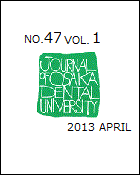Volume 44, Issue 1
Displaying 1-11 of 11 articles from this issue
- |<
- <
- 1
- >
- >|
-
Improved inner crown form in an electroformed telescope denture for the protection of abutment teethArticle type: Article
2010 Volume 44 Issue 1 Pages 1-7
Published: 2010
Released on J-STAGE: December 29, 2016
Download PDF (1568K) -
Article type: Article
2010 Volume 44 Issue 1 Pages 9-11
Published: 2010
Released on J-STAGE: December 29, 2016
Download PDF (347K) -
Article type: Article
2010 Volume 44 Issue 1 Pages 13-21
Published: 2010
Released on J-STAGE: December 29, 2016
Download PDF (2194K) -
Article type: Article
2010 Volume 44 Issue 1 Pages 23-39
Published: 2010
Released on J-STAGE: December 29, 2016
Download PDF (2734K) -
Article type: Article
2010 Volume 44 Issue 1 Pages 41-47
Published: 2010
Released on J-STAGE: December 29, 2016
Download PDF (32008K) -
Article type: Article
2010 Volume 44 Issue 1 Pages 49-55
Published: 2010
Released on J-STAGE: December 29, 2016
Download PDF (11968K) -
Article type: Article
2010 Volume 44 Issue 1 Pages 57-63
Published: 2010
Released on J-STAGE: December 29, 2016
Download PDF (741K) -
Intraductal injection of botulinum toxin induces functional changes in rat submandibular gland cellsArticle type: Article
2010 Volume 44 Issue 1 Pages 65-75
Published: 2010
Released on J-STAGE: December 29, 2016
Download PDF (34927K) -
Article type: Article
2010 Volume 44 Issue 1 Pages 77-81
Published: 2010
Released on J-STAGE: December 29, 2016
Download PDF (1661K) -
Article type: Article
2010 Volume 44 Issue 1 Pages 83-86
Published: 2010
Released on J-STAGE: December 29, 2016
Download PDF (450K) -
Article type: Article
2010 Volume 44 Issue 1 Pages 87-92
Published: 2010
Released on J-STAGE: December 29, 2016
Download PDF (645K)
- |<
- <
- 1
- >
- >|
